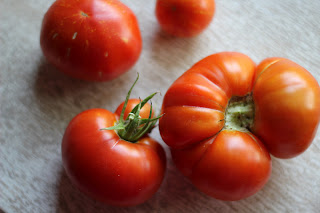To make mayonnaise, oil is added very slowly and beaten into a liquid mixture (which includes egg yolk and acid such as lemon juice). All the while it is whisked, the oil is broken down into smaller and smaller droplets. The mixture becomes thick as oil is suspended within the liquid and becomes mayonnaise.
In and of itself mayonnaise is fine and dandy. But to be honest, it's something I rarely use or crave.
As part of a thicker salad dressing, yes, but as a necessity on a sandwich? Not so much.
About a year ago out of complete necessity (trust me on this), I made mayonnaise.
Now, I knew what was in it, but had never made it before. Luckily the version I threw together turned out just fine.
Homemade mayonnaise is much different than store bought. It's amazingly different.
Perhaps life-changeingly so as far as condiments go.
Anyway, first of all, you know this condiment is fresh and you know exactly what went into it.
Then again, when making it at home, you're technically taking a walk on the wild side since a raw egg yolk is used. If you know the chickens personally though, you may not feel like you're taking your life into your hands. Pasteurized eggs are also an option.
Homemade mayonnaise is kind of impressive. Don't you think it would really impress your friends and relatives if you told them you made mayonnaise?
It CAN be done, and besides that, it can be said to be creamier and more flavorful than the store-bought version (as well as a lovely soft shade of pale yellow due to the egg).
Since homemade mayonnaise is much more perishable than store bought I suddenly wonder just what is in the bottled mayonnaises that makes them last as long as they do.
Since homemade mayonnaise is much more perishable than store bought I suddenly wonder just what is in the bottled mayonnaises that makes them last as long as they do.
One nice thing about mayonnaise as a sauce is that it's versatile.
It can be spread onto a sandwich.
It makes a nice little dressing when spooned into halved avocados (I think this is my favorite use).
Fresh mayonnaise can become a great dip for crudités or shrimp cocktail.
Or use it as part of a potato salad perhaps.
Fresh mayonnaise can become a great dip for crudités or shrimp cocktail.
Or use it as part of a potato salad perhaps.
(Aioli is a version of mayonnaise, often served with seafood or vegetables, but by definition it has to have garlic.)
The reason we use something like canola oil (vegetable oil, sunflower oil) for the mayonnaise is because it is a neutral-tasting oil (as compared to olive oil, sesame oil, walnut oil). Also, while it may sound like a good idea to use it, olive oil will apparently not always provide you with a stable mayonnaise: it can separate.
Perhaps you could try making mayonnaise with half canola and half olive oil for some of the flavor, but I don't know that I would add more olive oil than that.
Mayonnaise can be flavored however you would like: garlic, herbs, spices... the variations could be practically endless.
But this is how I like it- the light licorice flavor of tarragon with the bite of raw shallot.
Mayonnaise can be flavored however you would like: garlic, herbs, spices... the variations could be practically endless.
But this is how I like it- the light licorice flavor of tarragon with the bite of raw shallot.
makes about 1 1/3 cups
1 large egg yolk, room temperature
1/2 t Dijon mustard (5g)
1 T freshly squeezed lemon juice (15 ml)
1 t white wine vinegar (5 ml)
1 c canola oil (240 ml)
1 T minced shallot (10g)
1 T minced tarragon (4g)
1/2 t salt (3g), plus more to taste
1/4 t freshly ground black pepper (1g), plus more to taste
Whisk together egg yolk, Dijon mustard, lemon juice, and vinegar until combined. Slowly whisk in the oil, in a very thin stream, beginning a few drops at a time. Continue very slowly drizzling in the oil, whisking all the while, until all of the oil is combined and the mayonnaise is very thick (this could take 10 minutes). If at any point you add a little too much oil, stop pouring, and whisk the mayonnaise mixture until the oil is fully incorporated, then resume the slow addition of oil with the whisking. Once the mayonnaise is completely emulsified, whisk in the shallot, tarragon, salt, and black pepper. Taste the mayonnaise for seasonings and add more salt and pepper as necessary.
Refrigerated mayonnaise kept in a tightly closed container will keep for a week at most.

































